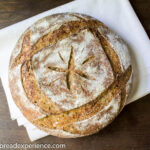Description
Indulge your senses with our Rustic Rye and Fennel Seed Pain au Levain. With its hearty texture, robust flavor, and aromatic hints of fennel, this variation on a classic is sure to become a beloved addition to your bread-making repertoire.
Ingredients
Units
Scale
Levain:
- 90 grams (3/4 cup) all-purpose flour
- 90 grams (1/3 cup + 1 Tbsp.) water
- 18 grams (1 Tbsp. + 1 tsp.) liquid sourdough starter (100% hydration)
Final Dough:
- 340 grams (2 3/4 cups) all-purpose flour
- 246 grams (2 cups) rye flour
- 425–475 grams (1 3/4-2 cups) water*
- 12 grams (2 1/4 tsp.) sea salt + 15-30 grams (1-2 tablespoons) water
- 12 grams (1-2 Tbsp.) fennel seeds, or other seeds as desired
Instructions
Day 1: Evening – Mix the Levain
- In a large bowl, combine the water and sourdough starter.
- Add the all-purpose flour and mix until fully hydrated.
- Cover the bowl with plastic wrap, or bees wrap, and let it rest at room temperature for 8-10 hours.
Day 2: Mix the Final Dough/Shape Loaf
- Pour the water over the levain and mix thoroughly with a wooden spoon or whisk to distribute.
- *Adjust the hydration according to the type/blend of flour used. Start with 350-375 grams and add in more water gradually until you get a workable dough. (I used a coarsely ground rye flour which made the dough thirsty.)
- Whisk together the all-purpose flour and rye flour, and add them on top of the water/levain mixture. Hold the salt for later.
- Mix the dough thoroughly using a dough whisk or wooden spoon to begin developing the gluten.
- Add the fennel seeds on top and incorporate thoroughly using wet hands.
- Cover the bowl and let the dough rest (autolyse) for 20-30 minutes.
- Sprinkle the salt over the dough and dissolve it with 15-30 grams (1-2 tablespoons) of water. Pinch and fold the dough to evenly incorporate the salt.
- Cover the bowl and let the dough bulk ferment for 2-3 hours. Stretch and fold the dough 2-3 times, at 40-minute intervals. Let it rest for the remaining time.
- Divide the dough, pre-shape it, and let it rest (covered) for 20 minutes to relax the gluten.
- Heavily dust a lined, round proofing basket with rice flour.
- Shape the dough into a boule (round shape) and place it seam-side up in the basket.
- Cover, and proof the dough in the basket for 30 minutes to an hour at room temperature.
- Cover tightly and place the loaf in the refrigerator to cold ferment overnight, approximately 8-12 hours.
Day 3: Bake the Loaf
- Place a bread cloche, Dutch oven, or Dutch oven combo baker on the lower shelf of the oven and preheat to 450°F (230°C) for at least 45 minutes.
- Remove the loaf from the refrigerator. Carefully invert the loaf from the proofing basket onto a sheet of parchment paper or a heavily dusted peel. Using a lined basket makes for easy removal, simply peel off the liner after flipping the loaf onto the parchment.
- Score the loaf with the pattern of your choice.
- When the oven and bread pot have preheated sufficiently, remove the lid and transfer the scored loaf (on the parchment) to the base of the baker. Use the “parchment sling” to transfer the loaf in and out of the baker to keep from getting burned. (If using a ceramic or stoneware baker, be sure to place the hot lid and base on a thick towel or potholder to keep them from shattering.)
- Bake each loaf 25 minutes with the lid on and 15-20 minutes with the lid off, for a total of 40-45 minutes.
- Remove the loaf to a wire rack and let it cool completely before slicing and serving.
Notes
Dough weight: approximately 1200 grams
- Category: Rye Bread
